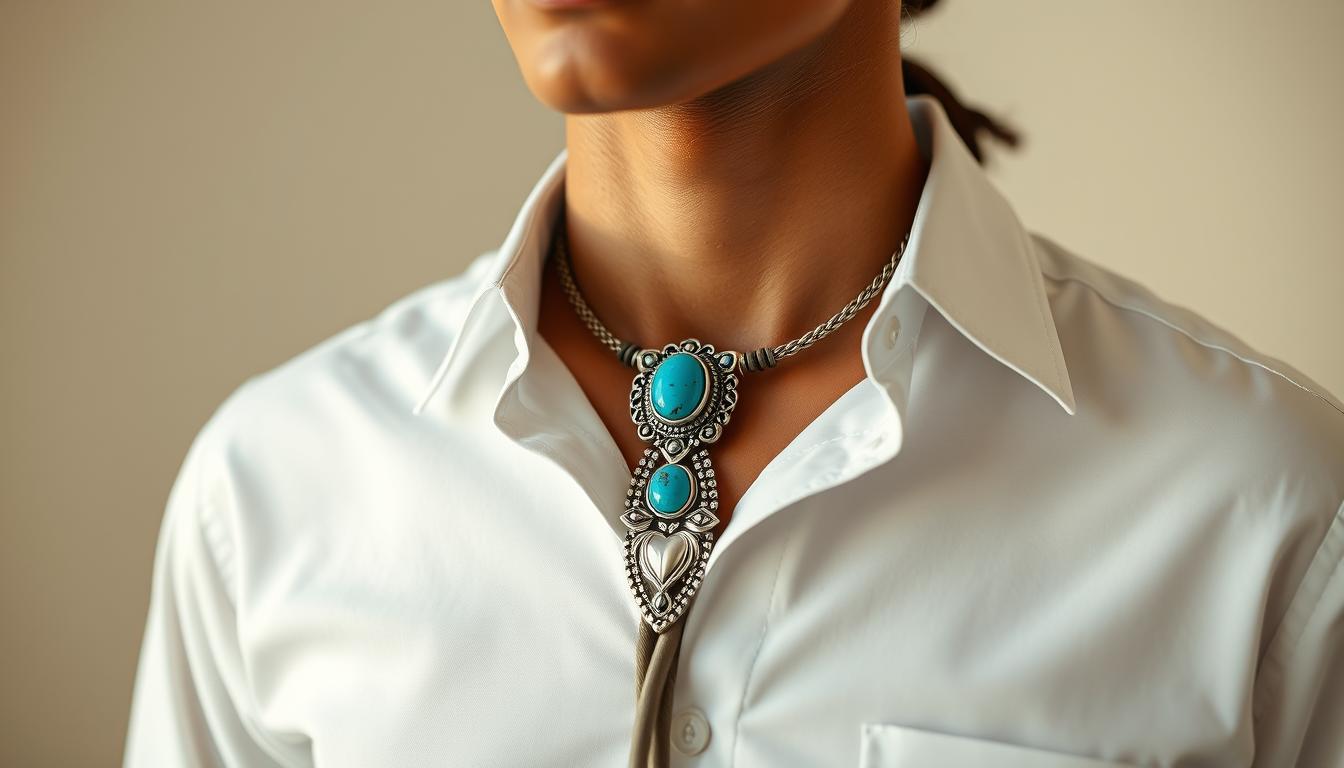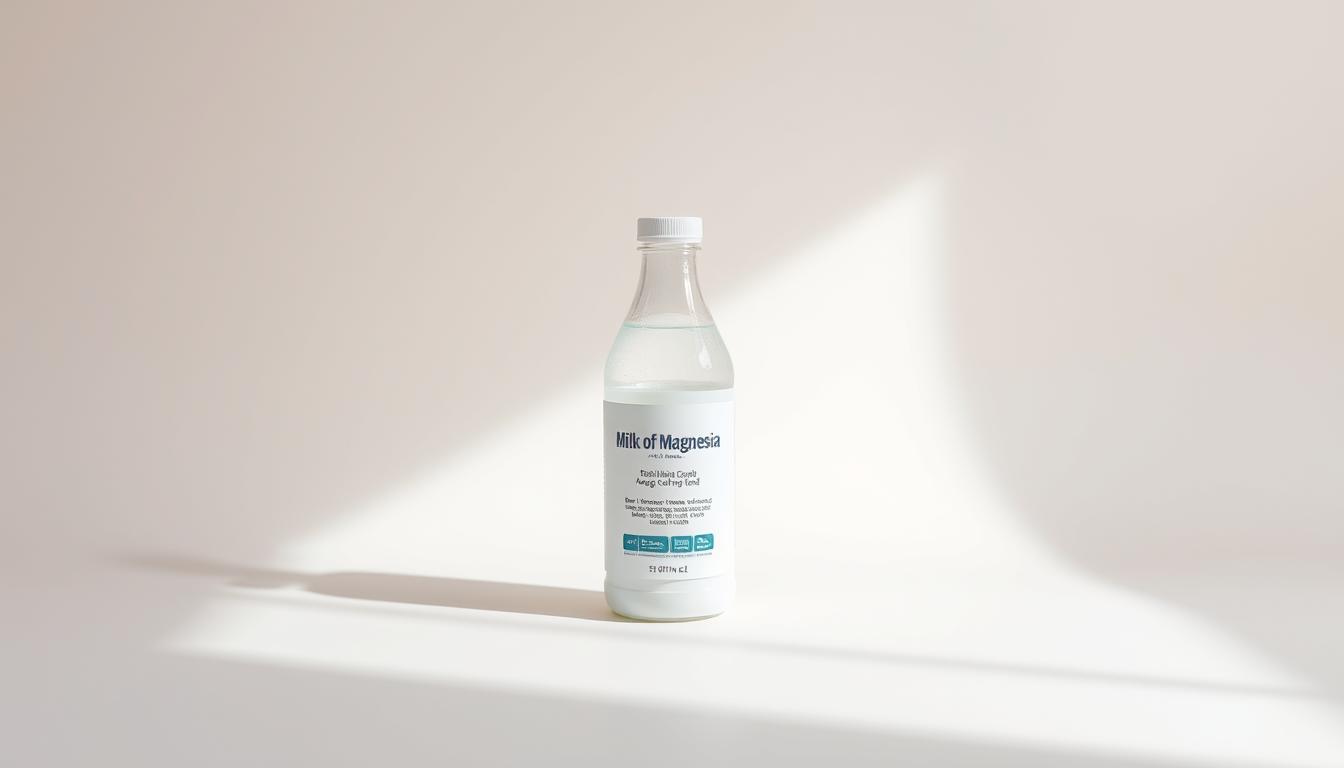Recovering from cataract surgery can be tough, but knowing about your eye shield is key. Your eye shield is very important during the healing time. It keeps your eye safe from bumps, scratches, and other issues that could harm your vision.
Doctors usually say to wear an eye shield at night for a week after surgery. It protects your eye from pressure or contact while you sleep. This helps avoid rubbing or touching the surgery area when you’re most tired.
How long you need to wear the eye shield at night can vary. It depends on how fast you heal and what your doctor says. Some people might need it for two weeks, while others might stop sooner.
Every person heals differently, and it’s important to listen to your doctor. They will tell you exactly how long to wear the eye shield at night. This helps you heal well and avoid any problems.
Key Takeaways
- Eye shields are critical for protecting your eye during initial cataract surgery recovery
- Nighttime shield use typically ranges from 1-2 weeks post-surgery
- Follow your surgeon’s specific recommendations for shield duration
- Consistent shield use prevents accidental eye contact during sleep
- Individual healing rates can impact shield wearing timeframe
Understanding the Importance of Eye Protection After Cataract Surgery
Cataract surgery is a big step towards clear vision. It’s key to protect your eyes after surgery for healing and to avoid problems. We’ll show you how to care for your eyes after cataract surgery.
Common Types of Post-Surgery Eye Protection
There are many ways to protect your eyes after cataract surgery:
- Protective eye shields
- Wraparound sunglasses
- Prescription protective glasses
- Special medical-grade protective covers
Why Nighttime Protection is Critical
Protecting your eyes at night is very important. Unconscious movements can damage delicate surgical sites, which can harm your recovery. The eye shield keeps your eye safe while it heals.
Risks of Not Using Eye Shield
Not using an eye shield can cause big problems:
- Potential infection
- Accidental eye trauma
- Disruption of surgical wound healing
- Increased inflammation
Doctors always tell you to follow your surgeon’s eye protection advice. This helps you recover well and see better.
How Long to Wear Eye Shield at Night After Cataract Surgery
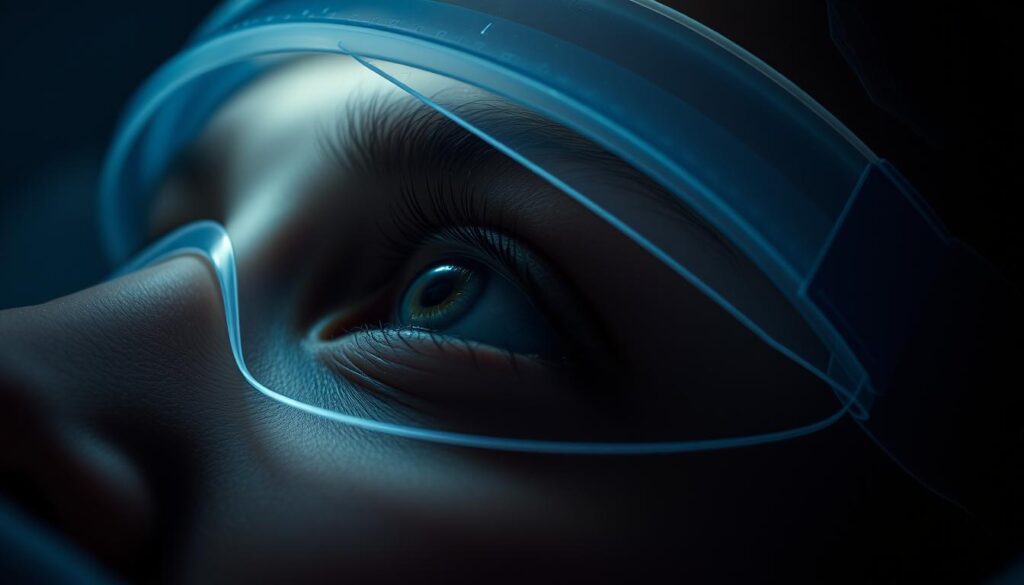
Knowing how long to wear an eye shield after cataract surgery is key for healing. Most people need to wear it at night for about one to two weeks. This shield is important for protecting your eye during the first healing phase.
The exact time for wearing the eye shield can change based on your healing and the doctor’s advice. Doctors usually give personalized advice based on:
- Type of cataract surgery
- Your eye health
- How fast you’re healing
- Risk of rubbing your eye while sleeping
Experts usually say to wear the eye shield all night for the first week after surgery. This stops you from touching or bumping your eye while you sleep. It helps keep the healing process safe.
Your eye doctor will check on your healing and tell you how long to wear the shield. Some might need it longer, while others can stop sooner.
Here are some tips for using the eye shield at night:
- Clean the shield before each use
- Make sure it fits well and is comfortable
- Follow your doctor’s exact instructions
- Tell your doctor if you feel any discomfort or unusual symptoms
Being patient during this time is important for healing well and keeping your vision healthy.
The Essential Role of Eye Shields in Post-Operative Care
After cataract surgery, your eye shield is key to your recovery. It keeps your eye safe from accidental touches. It also guards the surgery area when it’s most vulnerable.
Choosing the right eye shield is important for healing and safety. Our guide will show you how to pick and wear the best one.
Exploring Shield Materials and Designs
Eye shields vary in materials and designs, each with its own benefits:
- Plastic shields: Lightweight and clear
- Metal-rimmed shields: Add extra support
- Soft fabric shields: Comfortable for sensitive skin
- Adjustable strap shields: Stay in place securely
Achieving Proper Fitting and Positioning
Getting your eye shield to fit right is vital for protection. It should:
- Cover your eye fully without pressure
- Rest comfortably against your face
- Allow air to prevent moisture buildup
- Stay put while you sleep
Recognizing Ill-Fitting Shield Warning Signs
Look out for these signs that your shield might not fit right:
- Persistent discomfort or pressure
- Frequent slipping or movement
- Redness around the eye area
- Difficulty keeping the shield in place
Finding the right eye shield is a big part of recovering from cataract surgery. Talk to your eye doctor to find the best one for you.
Immediate Post-Surgery Eye Shield Protocol
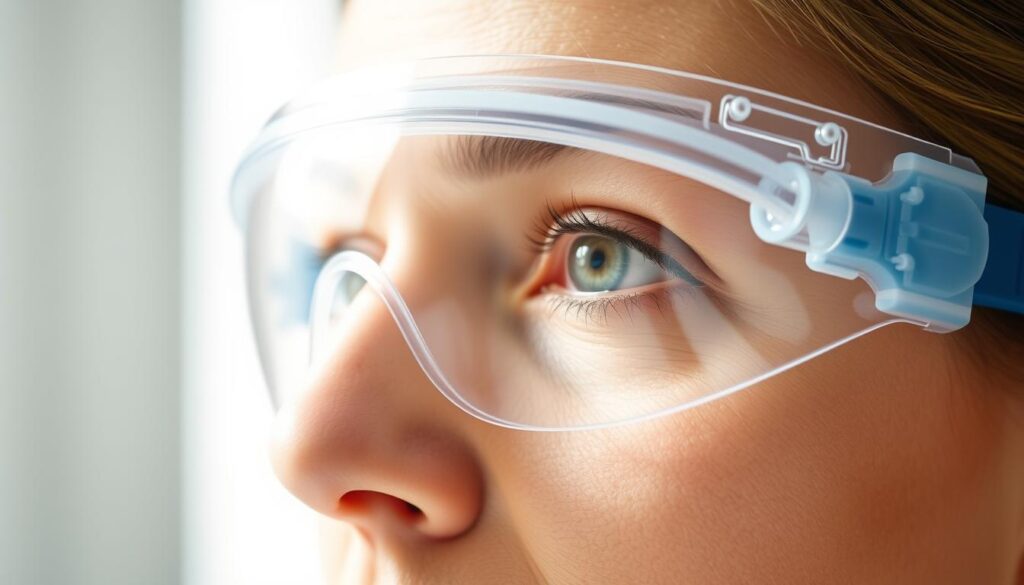
After cataract surgery, protecting your eyes is key. Your eye shield is vital in keeping the surgical area safe. It helps prevent complications.
Your ophthalmologist will give you a special eye shield right after surgery. This shield acts as a barrier against accidental touches or impacts. It’s important during the healing phase.
- Wear the eye shield continuously for the first 24 hours post-surgery
- Ensure the shield is securely but comfortably positioned
- Remove the shield only when instructed by your medical professional
- Clean your hands thoroughly before adjusting the shield
The first few hours are critical for recovery. Your eye is vulnerable and needs maximum protection. The shield reduces risks like infection and injury during this sensitive time.
Your medical team will give you specific instructions based on your surgery. Follow their advice closely. This ensures the best healing and avoids complications during your recovery.
Week-by-Week Eye Shield Usage Guidelines
Recovering from cataract surgery needs careful eye shield use. Our guide will help you protect your eyes at each healing stage.
Your eye shield is key in cataract surgery recovery. Knowing how long to use it helps avoid problems and aids healing.
First Week Requirements
In the first week, your eye shield is your main protector. Important steps include:
- Wear the eye shield all night
- Make sure it’s on tight
- Don’t touch or remove it without a doctor’s say
Second Week Adjustments
As you heal, your eye shield use will change. Your doctor might suggest:
- Wear it less at night
- Use a gentler way to attach it
- Watch your eye’s healing more closely
Long-term Protection Needs
Eye protection is important even after you’re better. We suggest a slow change:
| Recovery Stage | Shield Usage | Duration |
|---|---|---|
| Immediate Post-Surgery | Continuous Night Protection | 1-2 Weeks |
| Early Recovery | Intermittent Night Protection | 2-4 Weeks |
| Late Recovery | Occasional Protective Measures | 4-6 Weeks |
Always talk to your eye doctor for advice on your cataract surgery recovery.
Daytime vs. Nighttime Eye Shield Requirements
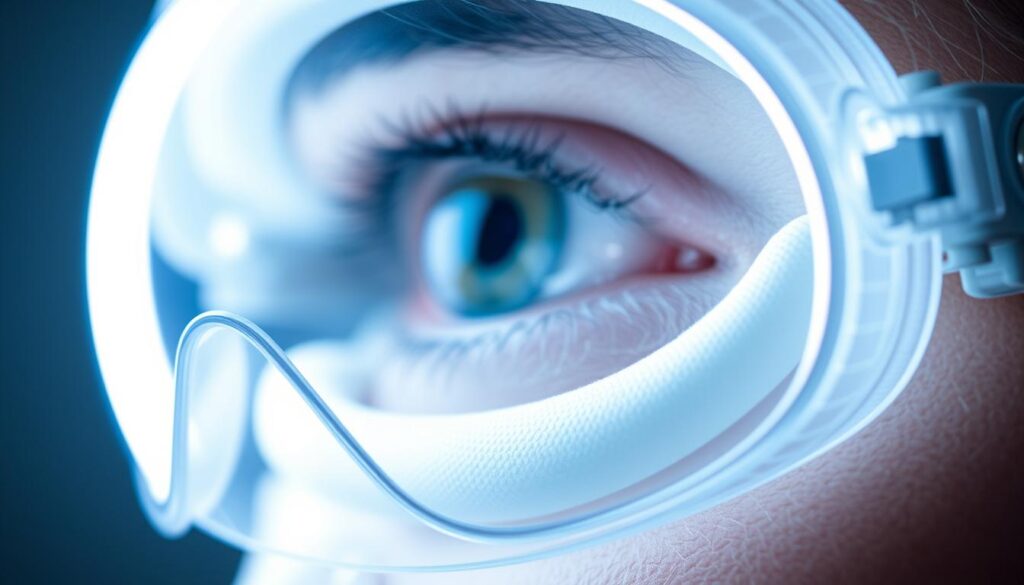
After cataract surgery, your eyes need special care day and night. Using an eye shield is key for healing, with different needs for each time of day.
At night, your eye shield is extra important. This is because you might move without realizing it while you sleep. Such movements could harm your healing eye.
- Nighttime shield provides complete protection from accidental touching
- Prevents unconscious scratching or rubbing during sleep
- Creates a physical barrier against possible infections
Daytime eye care is different. You might switch between regular eye shields and ones your doctor recommends.
| Protection Type | Daytime Usage | Nighttime Usage |
|---|---|---|
| Medical Eye Shield | Intermittent | Continuous |
| Protection Level | Moderate | Maximum |
| Risk of Injury | Lower | Higher |
Your eye surgeon will tell you when to switch eye shields. Always follow their personalized recommendations for optimal healing and recovery.
Proper Eye Shield Cleaning and Maintenance
Keeping your eye shield clean is key after cataract surgery. It stops infections and helps your recovery. Your eye shield protects your eyes, so it must be clean.
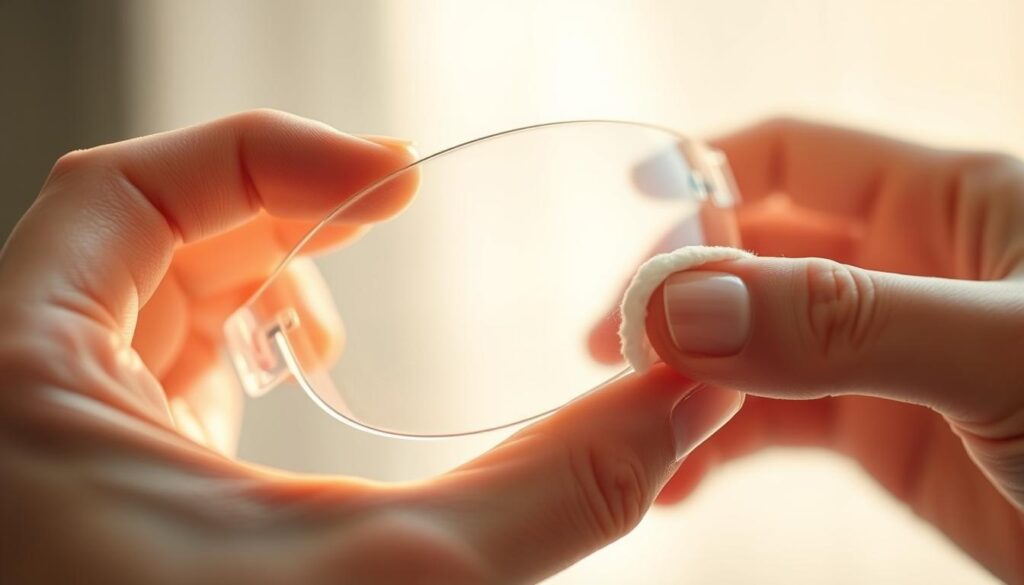
Good eye shield care means following a few important steps. Knowing how to clean it right can avoid problems and help you heal faster.
Essential Cleaning Methods
- Wash hands thoroughly before touching the eye shield
- Use mild, fragrance-free soap
- Rinse the shield with lukewarm water
- Gently pat dry with a clean, lint-free cloth
- Avoid harsh chemicals or alcohol-based cleaners
Cleaning Frequency Guidelines
How often you clean your eye shield depends on your recovery. Usually, clean it every day or as your doctor suggests. Always do what your surgeon tells you about using your eye shield.
| Cleaning Frequency | Recommended Action |
|---|---|
| Daily | Gentle cleaning with mild soap |
| After Activities | Quick rinse if exposed to dust or debris |
| Weekly | Thorough inspection for wear and tear |
When to Replace Your Eye Shield
Get a new eye shield if you see any of these:
- Visible cracks or damage
- Persistent discoloration
- Difficulty keeping it clean
- Recommended replacement by your doctor
Pro tip: Always have a spare eye shield ready during your cataract surgery aftercare. This ensures your eyes stay protected.
Common Complications from Improper Shield Usage
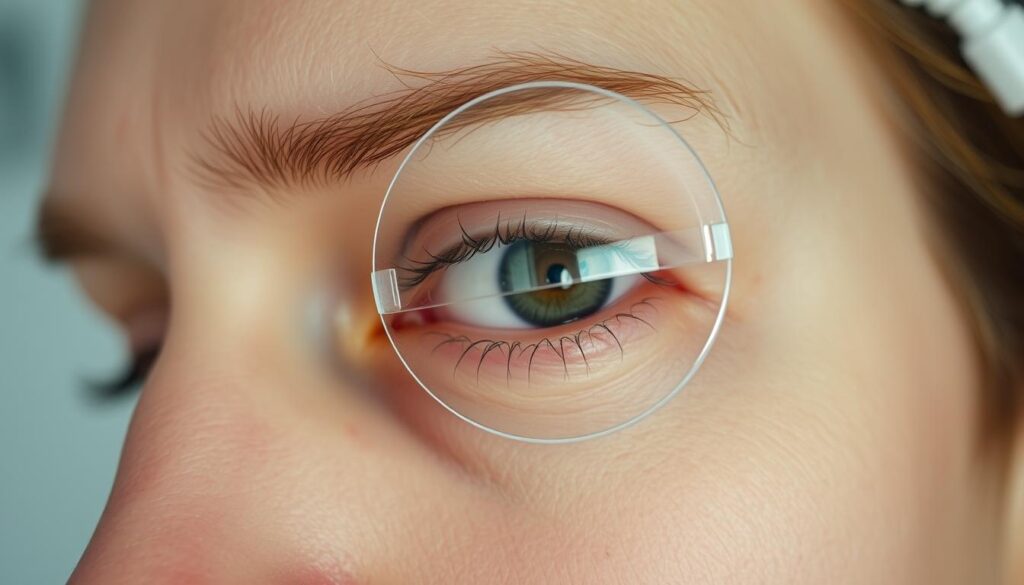
After cataract surgery, keeping your eyes protected is key. Not following eye shield guidelines can cause problems. These issues might slow down your healing.
Ignoring eye shield advice can lead to several issues during recovery:
- Increased risk of infection
- Accidental eye rubbing or touching
- Potential corneal damage
- Delayed healing process
The biggest risks from not using eye shields right include:
- Bacterial Contamination: Without a shield, bacteria can get into your eye.
- Mechanical Injury: Your eyes can get scratched or hit without protection.
- Inflammation: Not wearing a shield can cause your eyes to get inflamed.
Watch for signs like pain, discharge, or vision changes. These need quick doctor visits. Using eye shields as your doctor suggests helps avoid these problems.
Your eye shield is more than just a tool—it’s vital for healing. Wearing it correctly can help you recover faster and avoid complications.
Activities to Avoid While Wearing Eye Shield
After cataract surgery, keeping your eye safe is key. Your eye shield helps protect it. But, some activities can make it less effective and slow down healing.
After cataract surgery, it’s important to avoid certain activities. They can risk your recovery.
Physical Activities to Limit
Some physical activities need extra care during recovery:
- Avoid heavy lifting over 10 pounds
- Skip intense cardiovascular exercises
- Postpone contact sports
- Restrict bending and straining movements
Daily Task Precautions
When doing daily tasks, think about eye protection:
| Activity | Recommendation |
|---|---|
| Housework | Minimize dust exposure, avoid vigorous cleaning |
| Cooking | Use caution near steam and hot surfaces |
| Personal Hygiene | Gentle face washing, avoid direct water pressure |
Remember, your eye shield is your primary defense during recovery. Prioritize gentle movements and protect your healing eye from possible harm.
Signs of Healing and Recovery Progress
Recovering from cataract surgery takes time and attention. Your eyes will go through important stages that show they’re healing. Knowing these signs can make you feel more confident as you recover.
It’s key to know what healing looks like. Your vision will get better, and your eyes will hurt less over time. Here are some signs your eyes are healing well:
- Reduced eye redness and inflammation
- Decreased sensitivity to light
- Improved visual clarity
- Minimal eye discomfort
Most people see big improvements in the first few weeks after surgery. Everyone heals at their own pace. But, most notice big changes pretty quickly.
| Recovery Stage | Expected Healing Indicators | Typical Timeframe |
|---|---|---|
| Initial Recovery | Reduced eye discomfort | 1-3 days |
| Early Healing | Improved vision clarity | 1-2 weeks |
| Advanced Recovery | Stabilized vision | 4-6 weeks |
Pro tip: Keep track of your healing progress and maintain open communication with your ophthalmologist throughout the recovery period.
Every person’s recovery from cataract surgery is different. These signs are general, but healing speeds can vary. Always talk to your eye doctor for advice that fits your needs.
When to Contact Your Ophthalmologist
Dealing with cataract surgery aftercare can be tough. It’s important to know when to call your ophthalmologist. This ensures a smooth recovery and keeps your eyes healthy.
Experts say there are warning signs that mean you should see a doctor right away. Knowing these signs can help protect your vision and avoid problems.
- Sudden or intense eye pain
- Significant vision changes
- Increased redness or swelling
- Unexpected discharge
- Vision loss or sudden flashes of light
Make sure you have your ophthalmologist’s contact info handy while you’re recovering. Acting fast can stop small problems from getting worse.
| Symptom | Action Required |
|---|---|
| Moderate pain | Contact office within 24 hours |
| Severe pain | Immediate medical attention |
| Unusual vision changes | Schedule urgent consultation |
Your eye health is very important. Always trust your gut and call your eye doctor if something seems off during your recovery.
Transitioning Away from Eye Shield Use
Cataract surgery recovery means carefully removing your eye shield. Many patients wonder when and how to stop using it. Our guide will help you through this healing phase with confidence.
How long you wear your eye shield is key in the early recovery stages. Reducing shield use needs patience and watching your eye’s healing closely.
Gradual Reduction Protocol
Here’s a structured way to stop using your eye shield:
- Start by reducing nighttime shield use after the first two weeks
- Consult with your ophthalmologist about your specific recovery timeline
- Monitor your eye’s comfort and sensitivity during the transition
Signs You’re Ready to Stop Shield Use
Several signs show you’re ready to stop using the eye shield:
- No persistent discomfort or pain
- Reduced sensitivity to light
- Clear vision without significant inflammation
- Physician’s approval during follow-up appointments
Every patient heals differently. Your eye shield duration might vary. Always follow your doctor’s advice over general guidelines.
Listen to your body and talk openly with your eye care team. This ensures a smooth transition from eye shield use.
Alternative Eye Protection Methods
Protecting your eyes is key after cataract surgery. While eye shields are important, there are other ways to keep your eyes safe. These methods can make your recovery more comfortable.
There are many types of protective eyewear to choose from. They offer comfort and protection from irritants and impacts. This helps you heal well and stay safe.
- Wraparound Sunglasses: These glasses protect your eyes from UV rays and debris.
- Prescription Protective Glasses: They correct your vision and protect your eyes at the same time.
- Sports-Style Protective Eyewear: Great for active people who need extra protection.
Talk to your ophthalmologist before choosing eye protection. They can suggest the best options for you based on your healing and lifestyle.
Each protection method is best for different times in your recovery. Knowing the benefits of each helps keep your eyes safe day and night.
- Look at comfort and fit.
- Check if they block UV rays.
- Think about how they might affect your movement.
Your eye health is very important during recovery. Trying out these alternative protection methods can help you heal well. You’ll stay comfortable and flexible too.
Conclusion
Recovering from cataract surgery needs patience and careful eye shield use. Knowing how long to wear the eye shield at night is key. Our guide helps protect your vision and aid in recovery.
Following your doctor’s advice is vital for a good recovery. The eye shield is more than just a small item. It guards your eye during healing, keeping it safe from harm.
Every person’s recovery is different. Our guide offers helpful tips, but your doctor’s advice is most important. Stay on top of your eye health, go to follow-up visits, and ask questions about your recovery.
With the right care, you’ll soon see the world clearly again. Your commitment to following instructions will help you recover smoothly.




